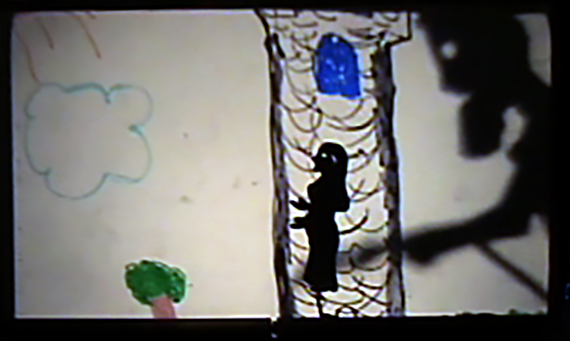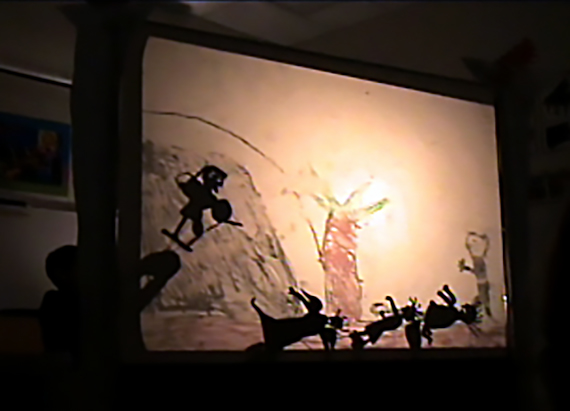Stories from Greek mythology, which tie in to Western art, literature, and music, have endless possibilities for class and parallel class projects, in which music and art teachers could also be involved. With the help of an overhead projector children can let Persephone grow colorful flowers, make Icarus fall in a very real sea, and even ride Pegasus themselves. If you are aiming for group projects rather than a performance, you can desktop screens without overhead projectors You can put up a small performance in a matter of hours, or spend weeks on something on a larger scale. On this site some information and ideas.

Puppets, light and screen
What kind of light and screen to use depends on what you want to do in the classroom. Do you want small groups to work from desktop screens and present to their classmates only? Or do you want to work from a large screen as a group, using an overhead projector?
- How to Make Puppets
- Desktop Patterns (may be enlarged on photocopier)
- Light and Screen
- How to make a pot-shaped screen (desk top use)
- Using an Overhead Projector
Individual or team projects on desk top screens
If you like the children to work on their own or in small groups it is possible to use desktop screens and puppets. Children could present their favorite gods or goddesses, heroes or mythic creature to their classmates, or do so in teams, for instance with a skit about couples from Greek mythology (Theseus and the Minotaur, Orpheus and Euridice, Apollo and Artemis etc.).
Alternatively, small groups of children may act out simple myths with few characters. The text can be provided in advance or written by the group itself after research. In this case, one of the children should act as the narrator.
Group or class projects with a larger screen
The use of one or two larger screens and an overhead projectors enhances the possibilities for a group performance for parents or other classes.
Performance of Pandora’s Box by 4th-5th graders
Pandora’s Box, a five minute performance shown above, was put together by a class of twelve 4th and 5th graders at a local Unitarian Universalist congregation in the context of the curriculum “Why Do Bad Things Happen?” The performance took six teaching hours to prepare, during which the students made puppets and masks, and decided about the evils stored in the box, which they drew on transparencies. The text was written and narrated by teachers. The preparation hours included practice time.
Choosing your myth(s)
When choosing which myth(s) to perform with your class you have to be practical. Are there enough roles to distribute or split? Can the story be visualized well, and are you able to use any “special effects”? Where does the theme fit in the curriculum? Do you want it to be a class project only, or are you working with teachers of parallel classes? If your school has the luxury of an art or music teacher, are there any possibilities for cooperation? How much time do you want to spend on the project?
If you want to keep it small and work with either desktop screens or one big screen, you can choose to have groups act out parts of a larger myth, such as the twelve labors of Herakles (Hercules). Alternatively, you can work on a group of myths around a certain theme. The Greek mythology for students series by Schlesinger Media (a set of 10 DVDs that you may be able to borrow through your library) gives an excellent introduction to themes in Greek mythology, with animations of some of the most famous myths.

Storyboarding and writing a script
If you are working on one project it is recommended to have the whole class involved in the storyboarding. This means you have to divide the story up into individual scenes, with not more than four characters in each (the maximum of children fitting behind the screen). Instead of using one screen you can use two, which increases the pace of the performance.
When deciding which scenes to include in the story it is important that the children understand the oral tradition in which myths were shaped. Stories were embellished and changed when they were passed on, resulting in many different traditions. Just like Greek poets, artists, and playwrights at the time, the children are free to decide which elements of a myth they want to include, emphasize, adapt, or leave out. After all, stories from Greek mythology have been used for different interpretations in literature and art up to this day!
In a parallel 4th grade class project of the stories of Perseus and Andromeda the class that acted out the story of Andromeda chose to let Perseus rescue Andromeda and fly back home on the back of Pegasus, the winged horse that was born from Medusa’s dead body. In none of the written sources in antiquity, however, this actually happens, and the image of Perseus riding Pegasus has only been used in art, centuries later. The children were aware of this, but were in favor of using Pegasus nonetheless, because it worked out better in the story.
Scene from the Andromeda myth (4th grade), using direct projection and transparent film on a rolling rack (instructions for the rack in David and Donna Wisniewski’s book Worlds of Shadow)
Timing and division of labor
Whichever story is chosen for a performance, there are always characters of more or less importance, and a long-winding story that provides enough scenes and characters for everybody may easily lose its thread. There are various ways around this problem, and with a bit of improvising it should be possible to make everybody feel they are involved and contributing to the performance.
It is always possible to split up main characters in the story, as long as they are recognizable, for instance by always having the same attribute (you can let the children do image research on Theoi Greek Mythology. Be prepared for giggles because of male nudity on vases!). Sometimes puppets should be held by two people, particularly when they are large, and when humidity makes the paper floppier. Alternatively, puppets can be made in different formats, allowing more children to act out the same character.
It may be wise to start your unit with an introduction during which all children make a puppet that can be taken home. After this they often know themselves if they would like to be a puppeteer, or prefer to play another part in the performance, for instance by drawing background sceneries on transparencies, be a narrator, or part of the overhead projector group (popular!) or the sound and music crew.
The 4th grade classes who performed the two Perseus myths mentioned above were divided into four groups: puppeteers (making and holding puppets and props), visual artists (making and projecting background scenes on the overhead projector), writers and narrators (narrating scenes they had written individually or as a group), and musicians. The latter group worked with the music teacher and composed and performed the music that accompanied the scenes.
- Going bigger: direct projection and masks
- How to act out Heracles’ labors using your own imagination
Performance ideas

If you provide a basic screen the children will easily come up with ideas about decorations. Two lamp poles supporting the screen (shown right) were decorated as temple pillars, made out of a white paper. The screen was connected to a second screen by another long piece of paper, behind which the children were hiding when they were not working behind a screen.
In addition to the narrators you may consider adding a chorus (speaking or singing) that comments on the events in the story, just like in real Greek theater.
There are many possibilities for an exciting time! Have fun!
